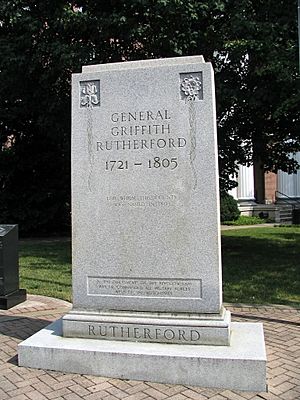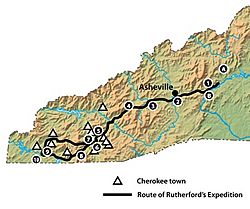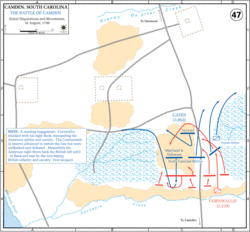Griffith Rutherford facts for kids
Quick facts for kids
Griffith Rutherford
|
|
|---|---|

Memorial for Griffith Rutherford in Murfreesboro, Tennessee
|
|
| Born | 1721 Ireland |
| Died | August 10, 1805 (aged 84) Sumner County, Tennessee |
| Allegiance | |
| Service/ |
North Carolina militia |
| Years of service | Colonial Militia 1760–1775
North Carolina Militia 1775–1783 |
| Rank | Colonial Militia
North Carolina Militia
|
| Unit | North Carolina militia |
| Commands held | Salisbury District Brigade, Rowan County Regiment |
| Battles/wars | French and Indian War
War of the Regulation |
| Relations | Married to Elizabeth Graham |
| Other work | Served in the North Carolina senate, settled in Sumner County, Tennessee, became President of the Legislative Council of the Southwest Territory (Tennessee) |
| Signature | |
Griffith Rutherford (born around 1721 – died August 10, 1805) was an important military leader and politician. He played a big role in the American Revolutionary War and the Cherokee–American wars. He was also a key figure in the early days of North Carolina and the state of Tennessee.
Rutherford was born in Ireland. When he was about 18, he moved with his parents to Philadelphia, which was then a British colony. In 1753, he moved to Rowan County, North Carolina, where he married Elizabeth Graham.
He started his military career during the French and Indian War, becoming a captain in the North Carolina Militia. He continued serving until the American Revolution began in 1775. He then joined the North Carolina militia as a colonel. In 1776, he became a brigadier general and fought against the Cherokee people. He also helped defeat British supporters (called Loyalists) at the Battle of Ramsour's Mill in 1780.
Later in 1780, he was captured by the British at the Battle of Camden. After being released in a prisoner exchange in 1781, he continued to fight. He led more attacks against the Cherokee.
Besides his military work, Rutherford was active in his community. He served in the North Carolina government. He was also a leader in the Southwest Territory (which later became Tennessee). He passed away in Sumner County, Tennessee, in 1805, at 84 years old.
Contents
Early Life and Family
We don't know much about Griffith Rutherford's very early life. He was born in Ireland, either in 1721 or 1731. His parents were John Rutherford and Elizabeth Griffin. Sadly, his parents died during the trip from Ireland to America.
When he arrived in Philadelphia, he worked on a relative's farm. There, he learned how to measure and map land. Around 1753, he moved to Rowan County, North Carolina. He bought land about 7 miles (11 km) from Salisbury, North Carolina.
In 1754, Rutherford married Elizabeth Graham, who was his neighbor's sister. They had ten children together. One of their sons, James Rutherford, became a major in the Revolutionary War. He died fighting at the Battle of Eutaw Springs. Griffith Rutherford also became good friends with the famous explorer Daniel Boone. They often went hunting and surveying together.
After the French and Indian War, Rutherford became more involved in his community. He served in the North Carolina government in 1766. He was also a sheriff and a justice of the peace for Rowan County from 1767 to 1769. He also worked as a tax collector.
Military Service Before the Revolution
Griffith Rutherford started his long military career in 1760. This was during the French and Indian War. He fought in several battles, including the Battle of Fort Duquesne in 1758. He also fought at Fort Dobbs in 1760. In 1761, he joined a campaign against the Cherokee people in the southern Appalachian Mountains. By the end of this war, Rutherford had become a captain.
Between 1769 and 1771, he supported the government during the War of the Regulation. This was a conflict where some colonists rebelled against unfair taxes and government control. Rutherford led a local militia group. They fought in the Battle of Alamance on May 16, 1771. After this battle, Rutherford went to Salem to recover from a painful illness called gout.
Fighting in the Revolutionary War
Rutherford joined the fight for American independence in 1775. He became a colonel in the North Carolina militia. His group helped to disarm and scatter British supporters (Loyalists) in South Carolina. This included the Snow Campaign in Ninety Six, South Carolina.
In 1776, Rutherford attended the Fourth Provincial Congress in Halifax, North Carolina. Here, he helped write the first North Carolina Constitution. He was also promoted to brigadier general. After this, he gathered an army of 2,400 men. They went to fight against the Cherokee, who had allied with the British and were attacking colonists.
Campaign Against the Cherokee
Rutherford's army met up with other groups in July 1776. They traveled through the Blue Ridge Mountains and crossed several rivers. They had a small fight with some Cherokee warriors near the Cowee Gap. Later, they joined forces with General Andrew Williamson of South Carolina.
The combined forces fought against Native American tribes. Rutherford's group lost three men, but the Native American tribes suffered heavy losses. By the end of the campaign, the army had destroyed 36 Native American towns. They also ruined many corn farms and chased away cattle. Rutherford returned to Salisbury in October and let his troops go home.
Later that month, Rutherford sent another group of cavalry (soldiers on horseback) to attack the Middle Towns. This group was led by Captain William Moore.
Battles in the Southern Colonies
The British believed the southern colonies, especially Georgia, were easy to attack. Even though the Americans won early battles, the South became a main target for the British in 1778. North Carolina's governor, Richard Caswell, knew the danger. He ordered the militia to get ready. Rutherford gathered his forces and moved them to South Carolina.
The British captured Savannah and Augusta by February. This weakened the American efforts. Rutherford moved his troops near Augusta. He supported General John Ashe during the Battle of Brier Creek on March 3. However, many soldiers' enlistments ended, and most of Rutherford's men went back to North Carolina.
The loss of Charleston in 1780 was a big blow to the American cause. It put North Carolina in great danger. Rutherford called back his remaining troops from South Carolina. He ordered all soldiers from Salisbury to gather near Charlotte, North Carolina. By early June, about 900 men had gathered.
Battle of Ramsour's Mill
After gathering troops in Charlotte, Rutherford learned that Loyalists were meeting at Ramsour's Mill. This was near what is now Lincolnton, North Carolina. He ordered his officers to break up the group before it became too strong. Rutherford moved his men to the Catawba River.
Another American officer, Colonel Francis Locke, also gathered troops. Locke's forces decided to attack the Loyalists right away. They didn't wait for Rutherford because of the distance. Locke's men surprised the Loyalists early on June 20. The Loyalists fought back but were eventually forced to retreat. Rutherford arrived shortly after, and the Loyalists were already running away.
Battle of Camden
The American army had suffered many losses in the South. Congress sent General Horatio Gates to rebuild the army in Charlotte, North Carolina. Gates decided to march towards Camden, South Carolina. This town was important for controlling the South Carolina countryside.
The battle took place at dawn on August 16, 1780. Rutherford and other North Carolina militia were in the middle of the American formation. During the fight, Rutherford was wounded and captured by the British. He was held prisoner for ten months in Castillo de San Marcos in St. Augustine, Florida. He was finally released in 1781 in exchange for another prisoner.
Later in the War
Rutherford returned home to Salisbury in September 1781. He found that British troops had raided his house. After a short time with his family, Rutherford trained and took command of 1,400 men. He then moved his forces towards the British at Wilmington, North Carolina.
In October and November, Rutherford pushed the Loyalists back into Wilmington. He then surrounded the city. This cut off the British's supplies and communication lines. The British commander soon learned that Cornwallis had surrendered at Yorktown. Because of this, the British forces quickly left Wilmington.
After Wilmington, Rutherford again fought the Chickamauga Cherokee in the west in 1782. He followed the same path he had taken seven years earlier. This campaign was also successful.
Life After the War
Griffith Rutherford was elected to the North Carolina Senate during the war in 1779. He continued to serve there until 1789. He was against giving back land to Loyalists who had supported the British. He helped the government take their land. In 1783, he ran for governor but did not win.
He was a strong Anti-Federalist. This meant he had concerns about the new United States Constitution. At a meeting in Hillsborough, North Carolina, in 1788, he questioned some parts of the Constitution. He voted against approving the Constitution. Because of this, he lost his seat in the State Senate. However, his reputation remained good, and he was later elected as a Councilor of the State.
Rutherford gained a lot of land in what was then called the Washington District. In September 1792, he moved with his family to this area. Today, this is Sumner County, Tennessee. Two years later, he became the President of the Legislative Council of the Southwest Territory.
Griffith Rutherford passed away in Sumner County, Tennessee, on August 10, 1805.
Legacy
Several places are named after Griffith Rutherford:
See also
- List of North Carolina militia units in the American Revolution



